Behaviour in Scottish schools: research report 2023
This report is the fifth (2023) wave of the Behaviour in Scottish Schools Research, first undertaken in 2006.
Chapter 5 – Changes over time
Summary of findings
Whilst the majority of staff in 2023 still perceive that all or most pupils are generally well-behaved around the school and in the classroom, perceptions of this among teachers and support staff have declined since 2016 and since the time series began in 2006. Headteachers’ perceptions of good behaviour have remained high across the time series. Staff continue to find that pupils engage in the majority of the positive behaviours in the classroom in all or most lessons.
However, there has been a general worsening of pupil behaviour since 2016 with primary and secondary staff having experienced decreases in most positive behaviours and increases in most of the low level disruptive, disengagement and serious disruptive behaviours around the school. While headteachers’ experiences have generally remained more positive, particularly in primary schools, teachers and support staff experiences of pupil behaviour in primary and secondary schools have been more negative across a wide range of behaviours.
Staff have seen increases in most of the classroom disengagement behaviours and low level disruptive behaviours in the classroom and around the school since 2016, particularly pupils persistently infringing rules, making cheeky or impertinent remarks, engaging in general rowdiness, mucking about and deliberately excluding others. Staff experiences of the most commonly experienced low level disruptive behaviours have also increased since 2006. For most part these behaviours have been rising since 2006, whereas for some such as pupil work avoidance teachers’ experience of this declined between 2006 and 2012 and then has increased at each survey wave since then. Reports of pupils being under the influence of drugs or alcohol has risen since 2016 as has use of digital technology/mobile phones abusively.
Reported incidence of serious disruptive behaviours has risen since 2016. This includes sexist abuse towards staff, general verbal abuse, physical aggression and violence towards staff and pupils in the classroom and around the school. The proportion of staff that have experienced at least one incident of general verbal abuse towards them personally in the last 12 months has risen among all staff types in primary and secondary schools since 2009, with the greatest rise occurring since 2016. The only serious disruptive behaviours that have remained low and largely unchanged since 2016 in primary and secondary schools are reported instances of abuse towards staff including racist, homophobic/biphobic/transphobic and religious abuse and abuse related to disability.
Across primary and secondary schools, abuse between pupils and physical destructiveness have also all increased. Whilst the overall proportion of staff who report having experienced use of a weapon towards other pupils and staff in the last teaching week was much lower (2-6%)[57] than the proportion reporting general verbal, physical and a number of other types of abuse this has increased since 2016. There has been a rise from 3% in 2016 to 11% in 2023 of primary support staff and from <1% to 6% of primary and secondary teachers having encountered use of a weapon towards other pupils in the classroom in the last teaching week. Since the time series began in 2006, reported encounters of pupil violence and aggression in the classroom towards other pupils has risen[58]. For example, 10% of primary teachers had dealt with physical aggression towards other pupils at least once a day in 2006, rising to 20% in 2023. The increases have been more marked among primary teachers and primary and secondary support staff. For some behaviours, such as physical aggression, this has not been a straightforward increase at each survey wave since 2006; rather reporting of this declined between 2006 and 2012 and has increased again after this. Therefore, among some staff types[59] reported physical aggression among pupils is broadly similar in 2023 as it was in 2006.
The qualitative research with school staff and local authority representatives also identified new and emerging patterns of challenging behaviour including vaping and in-school truancy, a rise in misogynistic views expressed by male pupils, and problematic use of mobile phones and social media. School staff and LA representatives identified underlying reasons for these changes in behaviour. These included:
- A perceived lack of consequences for pupils who engage in serious disruptive behaviour, particularly in the context of restorative approaches to relationships and behaviour
- A lack of support for pupils with additional support needs, particularly Autism Spectrum Disorders and ADHD
- Changes in society and parenting such as a general lack of respect, increased use of mobile phones and social media and parents’ attitudes to school and behaviour
- Disengagement from school and learning
- Poor mental health and lack of resilience among pupils.
Introduction
This chapter examines changes over time in primary and secondary schools between 2016 and 2023 in relation to a wide range of specific positive behaviours, low level disruptive behaviours and serious disruptive behaviours. It then presents changes over time for some key measures of pupil behaviour since the first wave of the survey in 2006.
Changes in behaviours between 2016 and 2023
Overall perceptions
Headteachers’ perceptions of general good behaviour have remained very similar to 2016 in both primary and secondary schools. The vast majority perceived all or most pupils to be well-behaved around the school and in the classroom. For example, 99% of primary headteachers reported all or most pupils being well-behaved around the school in 2023 compared with 100% in 2016. This was also supported by the qualitative findings that schools staff found the majority of pupils to be well behaved.
Whilst the majority of teachers and support staff still perceive that all or most pupils are well-behaved around the school (85% and 84% respectively) and most teachers perceive this to be the case in the classroom (69%)[60], there has been a decline in this since 2016. For example, in 2016, 87% of primary teachers and 79% of primary support staff reported that all or most pupils were generally well-behaved in the classroom compared with 74% and 62% respectively in 2023 (see Table 5.1).
| In the classroom | In the school | ||||
|---|---|---|---|---|---|
| 2016 | 2023 | 2016 | 2023 | ||
| Primary | Teachers | 87% | 74% | 96% | 88% |
| Support staff | 79% | 62% | 96% | 90% | |
| Secondary | Teachers | 86% | 65% | 93% | 83% |
| Support staff | 54% | 36% | 89% | 75% | |
Unweighted bases for 2023 – for teachers in the classroom (primary 668, secondary 1686) and around the school (primary 663, secondary 1659), support staff (primary 452, 580). For 2016 – for teachers in the classroom (primary 707, secondary 1795) and around the school (primary 704, secondary 1776) and for support staff in the classroom (primary 472, secondary 658) and around the school (primary 476, secondary 665).
Positive behaviour
The majority of staff continue to find pupils to be well-behaved in most of the specific locations around the school and on school trips[61], as shown in Chapter 4.
There has been a decline in reporting of positive behaviour in each of these locations among teachers in both primary and secondary schools. Teachers report that a lower proportion of pupils are well-behaved all or most of the time compared with 2016 in most of the locations they were asked about in the last week, including in corridors, toilets, playgrounds/social areas, other areas of the school grounds and on school trips. Among headteachers there was no notable change since 2016 in relation to experiences of pupil behaviour in most of these locations, with the exception of behaviour in the school toilets in secondary schools where headteachers reported a decline in the proportion of pupils who are well-behaved all or most of the time (from 96% in 2016 to 65% in 2023). Figures are shown in Supplementary Tables 4.3-4.8.
For primary schools, headteachers’ reporting of most types of positive pupil behaviour around the school has remained similar to in 2016. Headteachers have reported increased levels of some of these positive behaviours such as ‘pupils taking turns’ ‘always’ or ‘on most occasions’ from 82% in 2016 to 94% in 2023.
There has been a decline in most positive pupil behaviours around the school reported by secondary headteachers and teachers in both primary and secondary schools since 2016. These include pupils taking turns, making positive use of school facilities during breaks (e.g. the library, sports facilities), queuing in an orderly manner, challenging others’ negative behaviour and interacting supportively with one another. For example, in 2016, 71% of primary teachers reported that pupils queued in an orderly manner always or on most occasions compared with 58% in 2023. The most notable change was reported in relation to pupils respecting toilet/break/cloakroom areas always or on most occasions which fell from 50% to 15% among secondary teachers and 87% to 40% among secondary headteachers. Some aspects of behaviour were reported to have worsened among secondary teachers and not among secondary headteachers, such as pupils actively helping their peers and greeting staff pleasantly.
Similarly, across most of the positive behaviours asked about in the classroom, all staff, other than primary headteachers, report that a lower proportion of pupils are well-behaved in all or most lessons in the last teaching week compared with 2016. This is consistent across 11 of the 13 behaviours covered. For example, in 2023, 69% of primary teachers report pupils ‘listening to staff respectfully’ in all or most lessons compared with 85% in 2016, and 57% of primary support staff report this in 2023 compared with 69% in 2016.
Among primary school headteachers, perceptions of these positive behaviours in the classroom have not notably changed since 2016.
Low level disruptive behaviour
In the classroom
There has been an increase since 2016 in the reported level of pupils being referred to secondary headteachers for low level disruptive behaviour issues: 17% reported having a pupil referred at least once a day in 2016 compared with 38% in 2023. There has been no equivalent change among primary headteachers. A similar pattern is seen in the proportion of headteachers reporting that they think that teachers within their school have had to deal with low level disruptive behaviour in the classroom at least once a day. Eighty-two percent of secondary headteachers reported that they think teachers in their school have to deal with low level disruptive behaviour at least once a day in 2016 which increased to 92% in 2023. There was no change in primary headteachers’ perceptions of this.
Most low level disruptive pupil behaviours in the classroom reported by teachers and support staff have increased since 2016. For example, in 2016, 37% of secondary teachers and 29% of primary teachers reported dealing with cheeky or impertinent remarks or responses at least once a day. This rose to 63% among secondary teachers and 52% among primary teachers in 2023. Among primary school staff, some experiences of low-level disruptive behaviour have increased among teachers but not among support staff or headteachers, including: making unnecessary (non-verbal) noise (e.g. by scraping chairs, banging objects; getting out of their seat without permission; persistently infringing class rules and work avoidance. Similarly, among secondary school staff the following low level disruptive behaviour had only increased since 2016 for secondary teachers: making unnecessary (non-verbal) noise (e.g. by scraping chairs, banging objects); and hindering other pupils.
Around the school
There has been a rise in primary and secondary teachers’ experiences of all low level disruptive pupil behaviours around the school since 2016. The proportion of secondary headteachers reporting such behaviours has increased for most low-level disruptive pupil behaviours around the school, but there has been no equivalent increase among primary headteachers. Reports of each of these types of behaviours is greater among teachers than headteachers and greater in secondary schools than primary schools (Figures 5.1 and 5.2). For example, there has been a 15 percentage point increase since 2016 in the proportion of primary teachers having encountered pupils loitering in prohibited areas at least once a day (from 14% to 29%) and a 28 percentage point increase in the proportion of secondary teachers enountering this (from 40% to 68%).
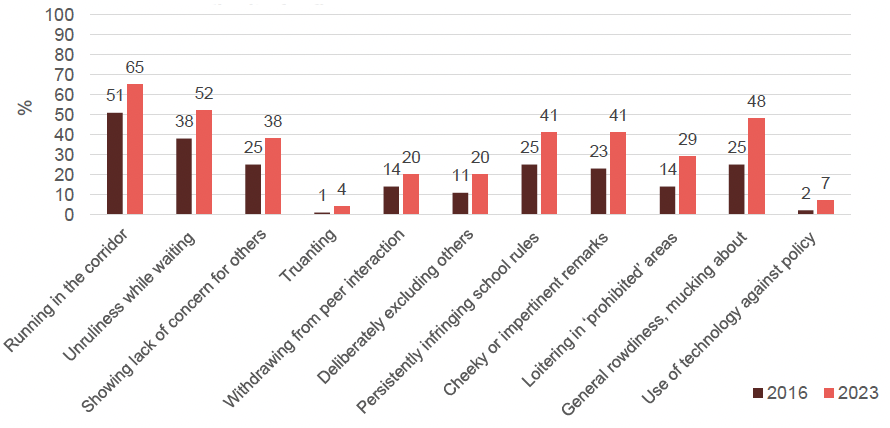
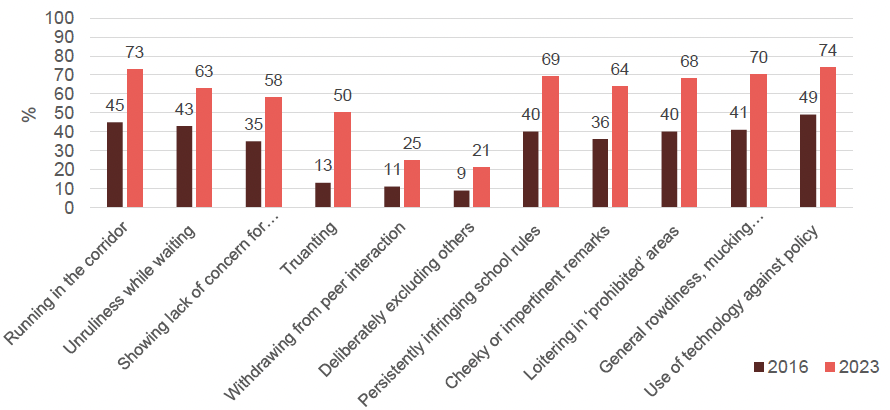
Disengagement
Experience of all four types of classroom disengagement behaviours that teachers and support staff were asked about has increased since 2016[62]. For example, pupils deliberately socially excluding others at least once in the last week has risen in primary schools from 55% to 69% (among teachers) and from 61% to 71% (among support staff). In secondary schools this has risen from 50% to 61% (among teachers) and from 61% to 73% (among support staff). In secondary schools there has been a particularly notable increase since 2016 in reports of pupils leaving the classroom without permission in the last teaching week. This has risen from 29% to 62% among teachers and 46% to 77% among support staff.
Report of pupils leaving school without permission, which can also be classified as a form of disengagement[63], has also risen among experiences of primary and secondary teachers. Among primary teachers this has risen from 10% in 2016 to 19% in 2023 and among secondary teachers from 44% to 70% in the last teaching week. This has also increased among secondary headteachers’ experiences from 62% in 2016 to 78% in 2023.
Serious disruptive behaviour
Physical and verbal abuse towards pupils
Primary school
There have been changes since 2016 in reported levels of physical and verbal aggression and abuse towards pupils in the classroom and around the school. The proportion of primary school staff that have dealt with physical destructiveness and serious disruptive behaviours in the classroom towards other pupils at least once a week has increased for teachers (in the classroom and around the school) and for support staff (in the classroom). For example, as shown in Figure 5.3, the proportion of primary teachers who reported encountering physical destructiveness at least once a week around the school has doubled since 2016, increasing from 26% to 52%. General verbal abuse towards other pupils around the school was also encountered by around half (54%) of primary teachers in 2023, which has increased from 39% in 2016. Physical aggression towards other pupils and physical violence towards other pupils have both increased since 2016 (from 45% to 58% and 32% to 46%, respectively).
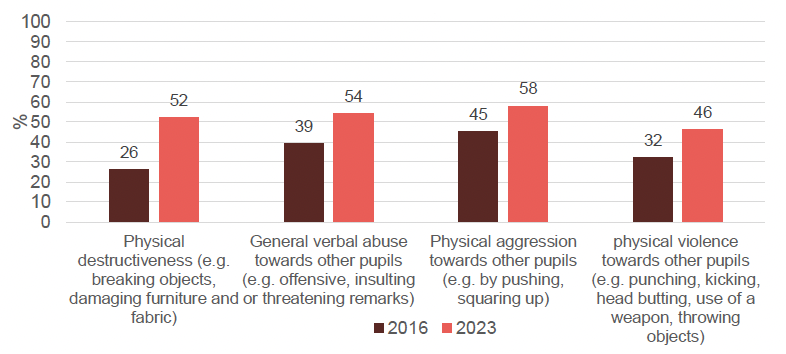
There has also been a small rise in experiences of most forms of abuse towards other pupils around the school such as racist abuse, sexist abuse, homophobic, biphobic or transphobic abuse and abuse towards pupils with additional support needs. For example, in 2016, 7% of primary teachers said they had encountered abuse towards pupils with additional support needs at least once a week compared with 13% who said the same in 2023. Reports of pupils using digital technology abusively in the classroom (e.g. malicious posting of comments, photos, videos) have also increased from 2% to 6% among teachers and 1% to 6% among support staff).
Use of a weapon towards other pupils in primary school
Similar to the trend with other behaviours, there has also been an increase in teachers experiencing use of a weapon towards other pupils in the classroom and around the school since 2016.
Staff who reported any experience of violent behaviour towards other pupils around the school were asked how frequently these incidents involved the use of weapon. For primary teachers (46% of whom had encountered violence between pupils around the school in the last week in 2023 and 32% in 2016), the proportion dealing with use of a weapon increased from 1% in 2016 to 11% in 2023. This equates to an increase from <1% to 5% of all primary teachers between 2016 and 2023.
Among the 49% of primary teachers who reported any experience of violent behaviour towards other pupils in the classroom in the last week in 2023 and 31% in 2016, the proportion dealing with use of a weapon increased from 2% in 2016 to 13% in 2023. This equates to a rise from <1% to 6% of all primary teachers. Among support staff[64] there has been an increase from 7% in 2016 to 19% in 2023 having dealt with the use of a weapon in the last week which equates to a rise from 3% to 11% of all support staff.
Secondary school
Similar to the trend for primary schools, there have been increases in many serious disruptive behaviours in secondary schools in the classroom and around the school since 2016. However, some behaviours do not show any change.
Reports of encountering pupils under the influence of drugs/alcohol around the school at least once in the last week has risen among teachers (5% to 16%) and head teachers (11% to 29%) and in the classroom among support staff (8% to 20%), teachers (6% to 17%) and head teachers (12% to 34%). Reports of pupils using digital technology abusively around the school has also risen among teachers (14% to 27%) and in the classroom among support staff (17% to 27%), teachers (10% to 27%) and head teachers (34% to 45%). This is shown in Figure 5.4 below.
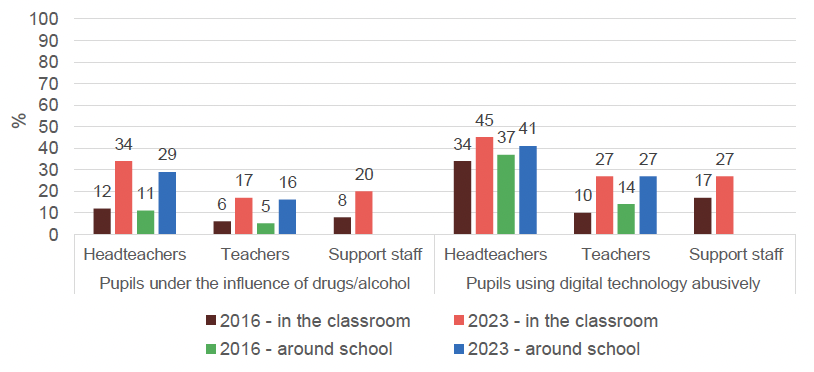
The rise among in the proportion of headteachers having experienced pupils using digital technology abusively around the school is shown in the figure however is not statistically significant. All other changes shown in the figure are significant.
The proportion of secondary school staff dealing with physical destructiveness and serious disruptive behaviour towards other pupils in the classroom at least once a week has increased for teachers, support staff and, for some behaviours, also among headteachers. This includes a rise in experiences of racist, sexist, homophobic, biphobic or transphobic abuse towards other pupils and abuse due to disabilities and additional support needs.
The greatest increases were reported in the level of racist, homophobic, biphobic or transphobic abuse towards other pupils. In 2016, 11% of secondary school teachers experienced homophobic abuse towards other pupils in the classroom at least once a week compared with 30% in 2023. There was a similar increase in homophobic abuse towards other pupils from 15% (in 2016) to 32% (in 2023) in the last week among secondary support. For secondary support staff, the greatest increase was in the level of racist abuse towards other pupils they experienced. In 2016, 13% of support staff reported experiencing racist abuse towards other pupils at least once a week, compared with 32% in 2023. Levels of sexist abuse rose more for support staff than among headteachers and teachers. Overall, the increase in abuse towards those with disabilities or additional support needs was lower than the rise in other types of verbal abuse. However increases in experiences of these were higher among support staff with a 14 percentage point rise in experiences of abuse towards other pupils due to a disability (14% in 2016 to 28% in 2023) and a 12 percentage point rise in experiences of abuse towards pupils with additional support needs (31% in 2016 to 43% in 2023) in the classroom[65]. Further, general verbal abuse, physical aggression and physical violence towards other pupils have all similarly increased. Most notably among secondary school teachers, who have reported levels of verbal abuse towards other pupils in the classroom in the last week increasing from 51% in 2016 to 75% in 2023, and physical aggression increasing from 30% in 2016 to 52% in 2023.
Use of a weapon towards other pupils in secondary school
Staff who reported any experience of violent behaviour towards other pupils around the school or in the classroom were asked how frequently these incidents involved the use of weapon.
Among the 36% of secondary teachers who reported experiencing this behaviour around the school in the last teaching week in 2023 and the 15% in 2016, there has been an increase from 4% in 2016 to 11% in 2023 having dealt with the use of a weapon. This equates to an increase from <1% to 4% of all secondary teachers between 2016 and 2023.
For the 44% of secondary support staff who encountered this behaviour in the classroom in the last week in 2023 and 17% in 2016, there has been an increase from 8% to 14% dealing with use of a weapon which equates to a rise from 1% to 6% of all secondary support staff between 2016 and 2023.
Abuse towards staff
Primary school
In line with changes in reported levels of physical and verbal aggression and abuse between primary pupils since 2016, many types of abuse and aggression towards staff have also increased whilst some have remained the same. Types of abuse towards staff that have increased since 2016 are shown in Table 5.2.
| 2016 | 2023 | |||||
|---|---|---|---|---|---|---|
| Headteachers | Teachers | Support staff | Headteachers | Teachers | Support staff | |
| General verbal abuse in the classroom | 31% | 8% | 19% | 46% | 28% | 34% |
| General verbal abuse around the school | 27% | 8% | - | 45% | 22% | - |
| Physical aggression in the classroom | 18% | 6% | 14% | 31% | 14% | 32% |
| Physical aggression around the school | 17% | 4% | - | 31% | 12% | - |
| Physical violence in the classroom | 15% | 3% | 13% | 30% | 12% | 28% |
| Physical violence around the school | 16% | 5% | - | 30% | 10% | - |
Unweighted bases for the above for 2023 – for headteachers (in the classroom 223, around the school 220), teachers (in the classroom 667 for all but physical aggression 668, around the school 649 for all but physical violence 647), support staff (in the classroom 448). For 2016 – for headteachers (in the classroom and around the school 291), teachers (in the classroom 705, around the school 701), support staff (in the classroom 473 for all but physical aggression 472).
Experiences of general verbal abuse towards staff in the classroom at least once in the last teaching week have increased from 19% in 2016 to 34% in 2023 among support staff, from 8% to 28% among teachers, and from 31% to 46% among headteachers. Reports of this type of verbal abuse around the school have also increased among teachers - from 8% to 22% - and headteachers - from 27% to 45%.
There has also been an increase among all staff groups in reported levels of physical aggression towards themselves or other staff. In the classroom the proportion of support staff who reported experiencing physical aggression at least once in the last week increased from 14% in 2016 to 32% in 2023. Among teachers there was an increase from 6% to 14% and among headteachers from 18% to 31%. Headteachers and teachers also reported increased levels of physical aggression around the school, from 17% to 31% among headteachers and from 4% to 12% among teachers.
The proportion of staff who reported experiencing physical violence towards themselves or other staff in the classroom in the last full teaching week has more than doubled for support staff and headteachers since 2016, rising from 13% to 28% and from 15% to 30% respectively. Among teachers, the levels of physical violence reported were lower than for both support staff and headteachers in both 2016 and 2023. There was, however, a fourfold increase in the level of physical violence experienced by teachers from 3% encountering this at least once in the last week in 2016 to 12% in 2023. The level of physical violence experienced around the school has also doubled or nearly doubled since 2016, from 5% to 10% for teachers and 16% to 30% for headteachers.
Personal experience of abuse in the last 12 months
Staff were also asked how many times they have experienced each of the forms of abuse[66] directed at them personally in the last 12 months. Reported abuse towards the staff member themselves due to protected characteristics remains very low in 2023. Between 0% and 2% of staff reported experiencing any incidents of racist, sexist or religious abuse, homophobic, biphobic or transphobic abuse, or abuse in relation to a disability. The proportion of staff having experienced general verbal abuse and physical aggression/violence directed at them in the last 12 months was much higher[67] and has increased since 2016 among all staff types. For example, among teachers experiences of at least one incident of general verbal abuse directed towards them has increased from 17% (in 2016) to 34% (in 2023). These increases are in line with the increase in the proportion of staff having experienced these forms of abuse towards themselves or other staff as shown above in Table 5.2.
Use of a weapon towards staff in primary schools
Staff who reported any experience of violent behaviour towards them around the school or in the classroom were asked how frequently these incidents involved the use of weapon.
Among the 10% of primary teachers who reported experiencing this behaviour around the school in 2023 and the 4% in 2016, there has been an increase from 13% in 2016 to 26% in 2023 having dealt with the use of a weapon in the last teaching week. This equates to an increase from <1% to 3% of all primary teachers between 2016 and 2023.
Among the 28% of primary support staff who reported experiencing this behaviour in the classroom in the last week in 2023 and the 13% in 2016, there has been an increase from 9% in 2016 to 32% in 2023 having dealt with use of a weapon in the last week which equates to a rise from 1% to 9% of all primary support staff. Among the 12% of primary school teachers who reported experiencing this behaviour in the classroom in the last week in 2023 and the 3% in 2016, the increase has been from 7% in 2016 to 19% in 2023 having dealt with the use of weapon in the last week. This equates to only a rise of <1% to 2% of all primary school teachers, which is not a statistically significant change.
Secondary schools
There have been changes since 2016 in the level of reported physical and verbal aggression and abuse towards secondary staff in the classroom and around the school. Reported experiences of abuse towards secondary school staff in the last teaching week remained low in 2023 (ranging from 0-5%) for racist abuse, homophobic, biphobic or transphobic abuse and abuse relating to religion, disability or additional support needs. However, there has been an increase in reported experiences of sexist abuse or harassment towards staff around the school and in the classroom among support staff, teachers and headteachers. For example, among headteachers, the proportion experiencing sexist abuse and harassment at least once in the last week increased from 3% to 12% around the school and from 3% to 14% in the classroom. Types of abuse towards staff that have increased since 2016 are shown in Table 5.3.
| 2016 | 2023 | |||||
|---|---|---|---|---|---|---|
| Head- teachers | Teachers | Support staff | Head- teachers | Teachers | Support staff | |
| General verbal abuse in the classroom | 54% | 23% | 25% | 61% | 48% | 45% |
| General verbal abuse around the school | 45% | 18% | - | 65% | 41% | - |
| Sexist abuse or harassment in the classroom | 3% | 1% | 3% | 14% | 7% | 7% |
| Sexist abuse or harassment around the school | 3% | 1% | - | 12% | 5% | - |
| Physical aggression in the classroom | 16% | 3% | 4% | 27% | 11% | 13% |
| Physical aggression around the school | 14% | 2% | - | 26% | 8% | - |
| Physical violence in the classroom | 2% | 0% | 1% | 11% | 3% | 7% |
| Physical violence around the school | 3% | 0% | - | 12% | 2% | - |
Unweighted bases for the above for 2023 – Unweighted bases for 2023 - for headteachers (in the classroom 134, around the school 130), teachers (in the classroom 1675-1681, around the school for general verbal abuse 1616-1620), support staff (in the classroom 576-579, for physical violence 577). For 2016 – for headteachers (in the classroom 190 and around the school 186), teachers (in the classroom 1775-1778, around the school 1757-1758), support staff (in the classroom 655-658).
There has been an increase since 2016 in reports of verbal abuse and physical abuse/aggression from pupils towards secondary school staff in the last teaching week. Experience of general verbal abuse directed towards staff in the classroom at least once in the last teaching week have increased from 25% to 45% among support staff and from 23% to 48% among teachers. Reports of general verbal abuse towards staff around the school in the last week have also more than doubled from 18% to 41% experiencing at least once among teachers and from 45% to 65% among headteachers.
Reported levels of physical aggression from pupils towards staff in the classroom at least once in the last week have increased among support staff (from 4% in 2016 to 13% in 2023), teachers (3% to 11%) and headteachers (16% to 27%). Physical aggression around the school at least once in the last week has also increased for both headteachers (from 14% to 26%) and teachers (from 2% to 8%).
The proportion of staff having experienced physical violence towards themselves or other staff in the classroom at least once in the last full teaching week has increased among support staff from 1% to 7% and among headteachers from 2% to 11%. The level of physical violence experienced around the school has also increased four-fold from 3% to 12% for headteachers.
Personal experience of abuse in the last 12 months
Staff were also asked how many times they have experienced each of the forms of abuse[68] directed at them personally in the last 12 months. Reported abuse towards the staff member themselves due to protected characteristics remains very low in 2023. The proportion of staff having reported incidents of racist, homophobic, biphobic or transphobic, or religious abuse, or abuse in relation to a disability or additional support needs has remained between 0-3%. However, the proportion experiencing sexist abuse towards themselves in the last 12 months has risen from 2% to 7% among support staff, 3% to 11% among teachers and 1% to 8% among headteachers.
As in primary schools, reports of any incidents of general verbal abuse in the last 12 months directed at the staff member have increased among support staff (26% to 42%), teachers (30% to 51%) and headteachers (33% to 55%). The same is true for incidents of physical aggression directed towards support staff (12% to 19%); teachers (12% to 24%); and headteachers (10% to 21%) and physical violence towards support staff (3% to 14%) and teachers (1% to 11%). This is shown in Figure 5.5.
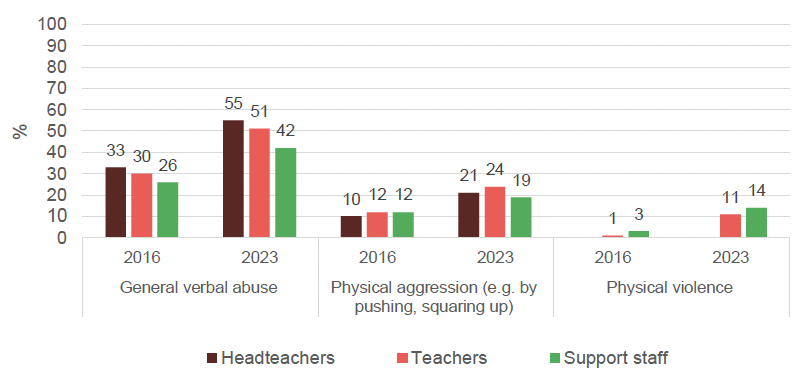
Use of a weapon towards staff in secondary schools
Staff who reported any experience of violent behaviour towards themselves or other staff around the school or in the classroom (2-4% of secondary staff) were asked how frequently these incidents involved the use of weapon.
Among the 12% of headteachers who encountered violence around the school in the last teaching week in 2023 and 3% in 2016, there has been an increase from 0% in 2016 to 15% in 2023 having dealt with the use of a weapon. This equates to a small overall increase from 0% to 2% of all primary headteachers between 2016 and 2023 which is not statistically significant.
Among the 7% of secondary support staff who encountered violence in the classroom in the last week in 2023 and 1% in 2016, there has been an increase from 0% in 2016 to 28% in 2023 having dealt with use of a weapon which equates to a small, and statistically insignificant, rise from 0% to 2% of all secondary support staff.
Longer term trends over time
This section describes trends for some key measures since the first Behaviour in Scottish Schools survey in 2006. These include measures of positive behaviour, low level disruptive behaviour and some types of serious disruptive behaviour toward other pupils. Personal experience of serious disruptive behaviour over the past 12 months was first asked about in the 2009 survey so changes over time in this section start from then.
Longer term trends in positive behaviour
Since 2006, there has been a decline in the proportion of primary and secondary support staff and teachers who think that all or most pupils are generally well-behaved in class (Figure 5.6). There has also been a smaller decline since 2006 in the proportion of primary school support staff (94% in 2006, 90% in 2023) and teachers (96% in 2006, 88% in 2023) who think that pupils are generally well-behaved around the school. Primary and secondary headteachers’ perceptions of overall behaviour both during lessons and around the school have remained positive since 2006.
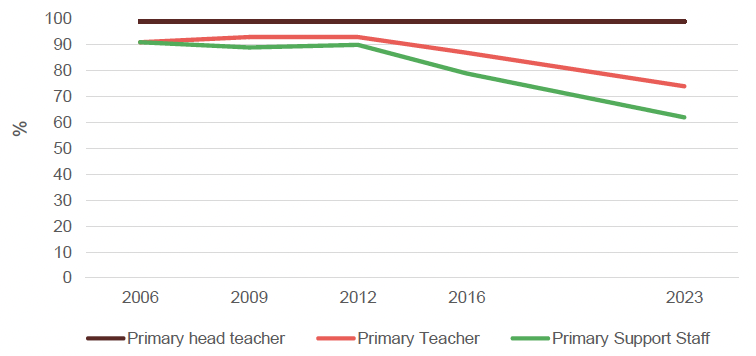
- No change among primary headteachers
- Decrease among primary support staff and teachers from 2016 to 2023 (and between 2006 and 2016)
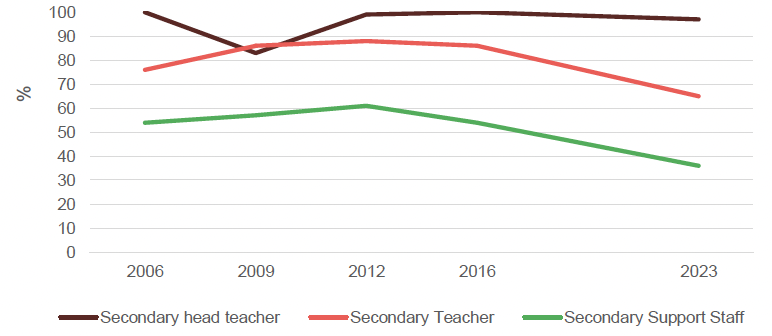
- No change among secondary headteachers between 2006 and 2023
- Decrease among secondary teachers from 2016 to 2023 (and since 2006)
- Decrease among seconday support staff from 2016 to 2023 and from 2012 to 2016 (and since 2006)
Similar decreases can be seen amongst secondary support staff and teachers (Figure 5.7). In 2006, around half (54%) of secondary support staff reported that all or most pupils were generally well-behaved in the classroom, this remained relatively stable from 2009 to 2016 before a decline to around a third (36%) in 2023.
Across the same time period, views of secondary support staff about behaviour around the school has followed a different pattern (Figure 5.9). In 2006, 79% of secondary support staff reported that all or most pupils were generally well-behaved around the school. This increased in 2012 and 2016 to 84% and 89% respectively, before declining in 2023 to a similar level to 2006 (75%). A similar pattern was seen with secondary teachers, although the reported levels were generally higher (ranging from a high of 94% in 2012 to a low of 83% in 2023).
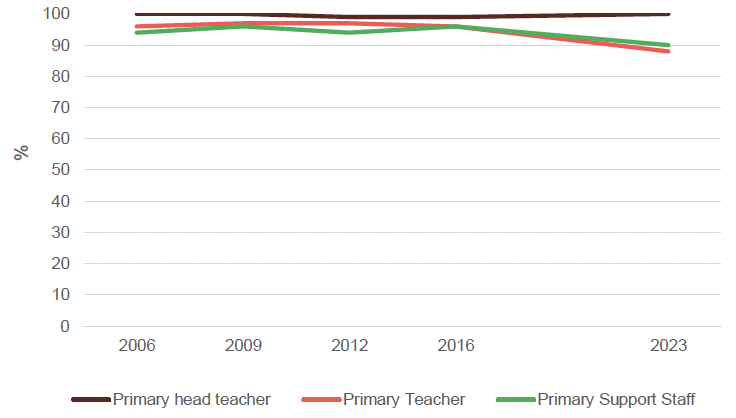
- No change among primary headteachers
- Decrease among primary teachers and support staff from 2016 to 2023 (no change in any previous years)
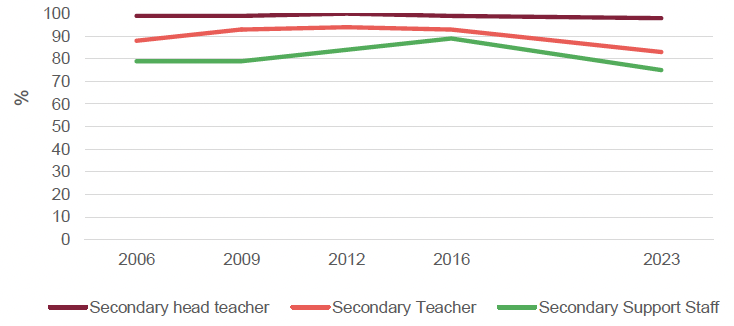
- No change among secondary headteachers
- Decrease among secondary teachers from 2016 to 2023 (with an increase between 2006 and 2016)
- Decrease among secondary support staff from 2016 to 2023 (with an increase between 2006 and 2016)
Longer term trends in low level disruptive behaviour
Between 2006 and 2023, the three low level disruptive behaviours which were most commonly reported by both support staff and teachers have remained consistent. They were: talking out of turn, hindering other pupils and work avoidance. However, in 2023, all three of these behaviours are being experienced more often by primary and secondary support staff and teachers than they were in 2006.
The reported level of pupils talking out of turn in the classroom at least once a day increased from 63% in 2006 to 83% in 2016 among primary support staff (Figure 5.10). Among primary teachers, the increase in reported levels can be seen from 2012, rising from 73% to 90% in 2023. Among secondary teachers, the proportion who reported pupils talking out of turn in the classroom at least once a day remained relatively stable between 2006 and 2016, before increasing between 2016 and 2023 from 75% to 85%. Views of secondary support staff have changed less over time. This group were more likely than others to report experiencing talking out of turn at least once a day in the last week in 2006 with 80% saying so, rising to 89% in 2023.
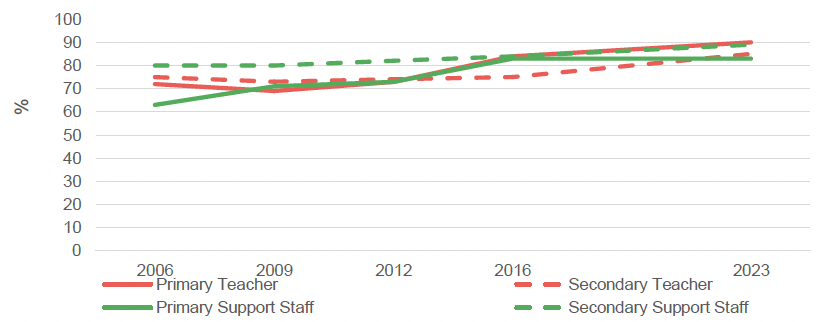
- Increase among primary and secondary teachers and secondary support staff from 2016 to 2023
- No change among primary support staff since 2016
- Increase for all from 2006 to 2023
Reported levels of staff experiencing pupils hindering other pupils in the classroom have increased since 2006 among all teachers and support staff (Figure 5.11). The overall increase has been less pronounced among secondary support staff – rising from 72% in 2006 to 82% in 2023 - than primary support staff – increasing from 51% to 73%. Reported levels among primary teachers increased at a level similar to support staff - from 54% in 2006 to 79% in 2023. Secondary teachers also reported a notable increase in experiencing this behaviour, from 59% to 76%. The reported levels of experiencing pupils hindering other pupils in the classroom rose most sharply between 2016 and 2023 for all staff groups except primary support staff, where the greatest increase occurred between 2012 and 2016 (from 60% to 71%).
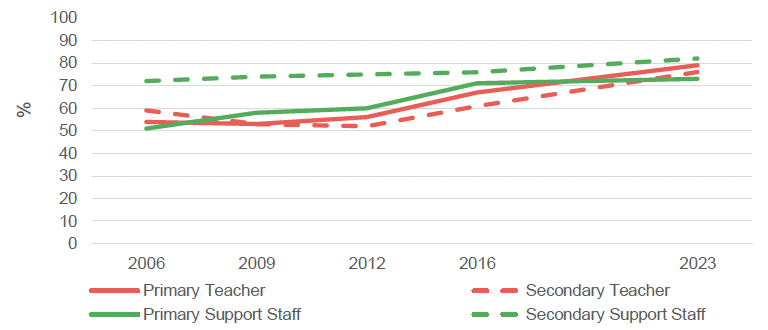
- Increase among primary and secondary teachers and secondary support staff from 2016 to 2023
- No change among primary support staff since 2016
- Increase for all from 2006 to 2023
Following these trends, there has been a similar increase in the levels of pupil work avoidance in the classroom reported by all teachers and support staff between 2006 and 2023 (Figure 5.12). The increase is greater (between 32-33 percentage point increase) among primary staff than secondary staff (between 19-23 percentage point increase). For primary and secondary teachers, reported levels declined up until 2012 before rising between 2012 and 2023. For example, in 2012, only 3 in 10 (30%) primary teachers reported having to deal with work avoidance at least once a day, rising to 5 in 10 (50%) in 2016 and nearly 7 in 10 (69%) in 2023. Primary and secondary support staff are almost twice as likely to have experienced work avoidance at least once a day in 2023 compared with 2006. For example, 34% of primary support staff experienced this at least once a day in 2006 compared with 67% in 2023.
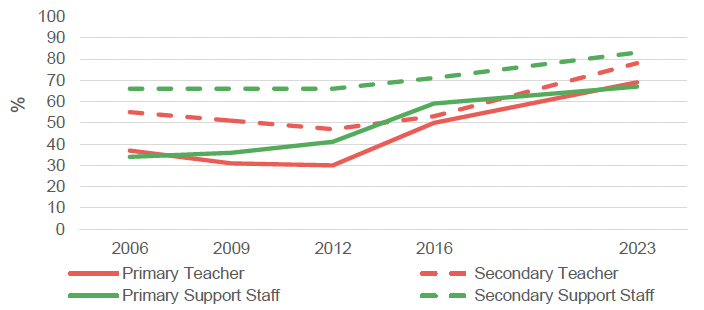
- Increase among primary and secondary teachers and support staff from 2016 to 2023 (all increased since 2006)
Longer terms trends in serious disruptive behaviour
After initially declining between 2006 and 2012, staff experience of pupil aggression towards other pupils in the classroom (at least once a day in the last week) has been consistently increasing (Figure 5.13). For headteachers and secondary support staff, this means that experiences in 2023 are broadly similar to those in 2006. For example, 8% of primary headteachers reported experiencing pupil aggression towards other pupils in class at least once a day in 2006 compared with 10% in 2023. In contrast, reported levels among primary teachers and support staff and secondary teachers have risen since 2006. For example, 10% of primary teachers had encountered physical aggression towards other pupils in 2006, rising to 20% in 2023.
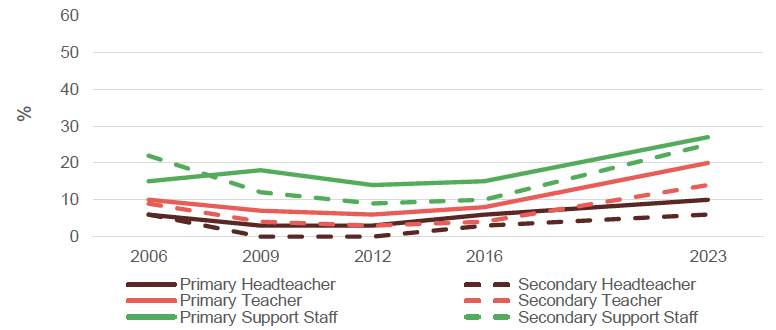
- Increase among primary and secondary teachers and secondary support staff from 2016 to 2023 (and since 2006 except among secondary support staff)
- No change among primary and secondary headteachers since 2006
Patterns in experiences of pupil violence towards other pupils in the classroom at least once a week since 2006 are similar to those seen in relation to pupil aggression (Figure 5.14). For all staff groups, there is a decrease in the proportion encountering this behaviour between 2006 and 2012 followed by a steady rise between then and 2023. Amongst headteachers and secondary support staff, again this means levels in 2023 are similar to those reported in 2006 (though the differences between these groups are wide). For teachers and primary support staff however, the proportion experiencing this behaviour in 2023 is notably higher than in 2006, with a particularly stark increase since 2016. For example, 8% of primary teachers reported encountering physical violence towards other pupils at least once a week in 2006, this decreased to 6% in 2012 before rising to 16% in 2023. A similar rise from 2006 is reported by secondary support staff (from 6% to 14% in 2023).
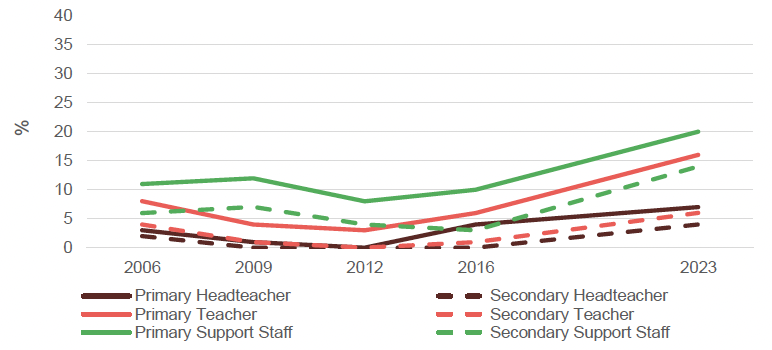
- Increase among primary and secondary teachers and secondary support staff from 2016 to 2023 (and since 2006 except among secondary teachers)
- No change among primary and secondary headteachers since 2006
The proportion of staff that have experienced at least one incident of general verbal abuse towards them personally in the last 12 months has risen among all staff types since 2009 (Figure 5.15). The greatest increase occurred between 2016 and 2023, ranging from a 17 to a 22 percentage point rise. Around 3 in 10 (31%) secondary headteachers reported at least one incident of verbal abuse towards them personally in 2009, rising to over 5 in 10 (55%) in 2023. Between 2006 and 2016 increases were low, ranging from 3 to 4 percentage points.
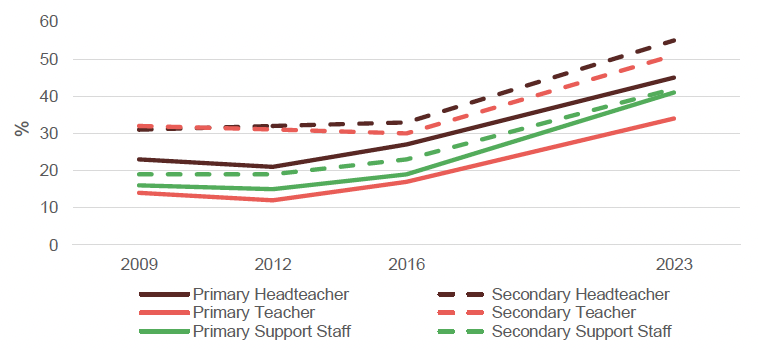
- Increase among all primary and secondary staff types from 2016 to 2023 (and between 2006 to 2023)
- Previous increase from 2012 to 2016 among primary and secondary support staff
The proportion of staff having experienced at least once incident of physical aggression and physical violence towards them in the last 12 months has also increased since 2009 for all staff types (Figures 5.16 and 5.17). As with verbal abuse, the greatest increase in personal experiences of physical aggression and violence has occurred since 2016, except among primary support staff where this increased the most between 2012 and 2016. Since 2009, experiences of physical aggression have increased more among primary staff (increasing by between 21 and 25 percentage points) than secondary staff (increasing by between 9 and 11 percentage points). The pattern is similar for experiences of physical violence with increases of between 20 and 28 percentage points among primary staff and between 6 and 10 percentage points among secondary staff. Increases in personal experience of aggression and violence have been just as pronounced among headteachers as among teachers and support staff.
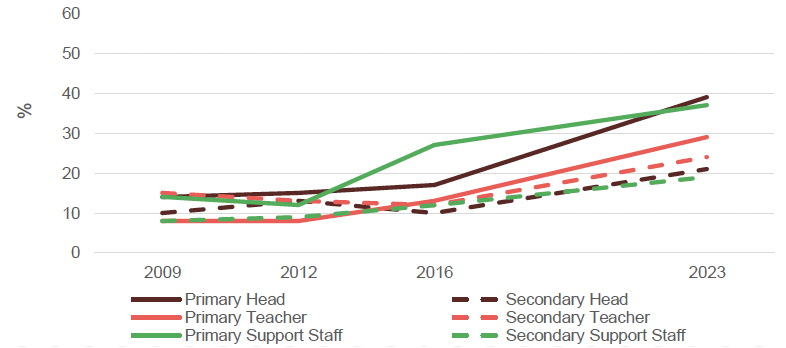
- Increase among all primary and secondary staff types from 2016 to 2023 (and between 2006 to 2023)
- Previous increase from 2012 to 2016 among primary teachers and support staff
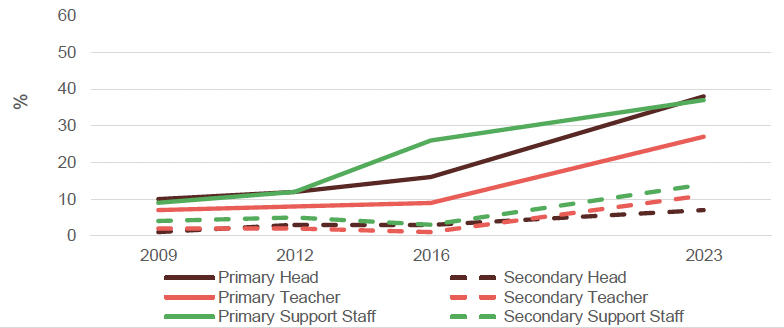
- Increase among all primary and secondary staff types from 2016 to 2023 (except for secondary headteachers)
- Increased for all primary and secondary staff types between 2006 to 2023
- Previous increase from 2012 to 2016 among primary support staff
Experiences of changing behaviour
When speaking about the changes they had seen in behaviour in recent years, school staff and LA representatives generally reported changes which are similar to those identified in the quantitative findings. In addition, a number of emerging behaviours were identified which are not captured by the survey.
Positive behaviour
Despite the survey results indicating that positive behaviour in schools has decreased since 2016, the majority of school staff, interviewed as part of the qualitative research, described the behaviour in their schools as being generally good with only a small number of pupils displaying behaviour which was disruptive or challenging. Staff reported that most pupils behaved well, giving examples of positive behaviour such as pupils being polite and kind to one another, following instructions and engaging with their work. However, the number of children within a school who exhibit disruptive behaviour was perceived to have increased.
“The pupils within the school, I would say about 90% of them give us absolutely or next to no bother at all when it comes to behaviour. They might need the odd reminder, they're a bit noisy, they're a bit boisterous, but generally, other than that, they are great.” (Primary headteacher)
Where schools gave examples of positive improvements to behaviour in recent years, these included young people being kinder and more tolerant of difference and having a greater interest in social justice.
“Other students are comfortable being friends with any student from any walk of life, or any race, or sexual orientation, or any of that sort of stuff. It seems to be a positive thing, this behaviour has changed.” (Secondary teacher)
Negative changes in behaviour
One of the most marked changes in behaviour since 2016 identified in the survey was the increase in verbal abuse, physical aggression and physical violence in both primary and secondary school. This was echoed in the qualitative research by school staff and LA representatives who reported an increase in the frequency of young people biting, spitting, kicking, slapping, punching, pulling hair, scratching, throwing chairs and tables and damaging classrooms. While school staff acknowledged that it was only a small minority of pupils exhibiting these behaviours, it could have a serious impact on teaching staff including, in some cases, injury, hospitalisation and sickness absence. This was particularly observed among pupils with the greatest support needs, including those with ADHD and ASD diagnoses. LA representatives, while more often using the terms “distressed and dysregulated behaviour”, noted increasing numbers of incidents involving violence and aggression being reported through their local authority-wide health and safety reporting systems.
“Physical violence for me is the one thing that's really escalated. What can you do when a child's attacking you, besides keep moving away? Then if they follow you, where do you go? You've got nowhere to go.” (Primary support staff)
“I wouldn’t say it’s just secondary schools, and I would say its primary schools and what I would say is that we’ve noticed a real increase in that distressed and dysregulated behaviour with our younger children.” (Local authority representative)
The use of swearing and bad language within school was also noted to have increased, both in the way that pupils speak to one another and also directed towards school staff. It was suggested that this change may reflect a more relaxed attitude towards swearing in society in general and that pupils may have had more exposure to such language in the home during lockdown. When speaking about both the increased exposure to violence and physical aggression, and verbal abuse and swearing, school staff noted the lack of parity with other professions which have a zero-tolerance approach towards swearing, physical violence and aggression.
There is the swearing, there's a lot more swearing at staff, and staff don't like that. Nobody comes into their work to be swore at. It's as if you have to accept it. It's alright for you to get sworn at. I don't agree with that because I don't feel like if you're in another workplace that it would be okay for somebody to come in and swear at you. (Secondary teacher)
A final theme which emerged from the interviews regarding changes in behaviour was a general reduction in levels of respect and a change in attitude among pupils. School staff spoke about pupils lacking respect both in their behaviour towards one another and towards school staff, with examples given of pupils being unkind and thoughtless towards one another, repeated vandalism within the school and using inappropriate and offensive language. This was discussed alongside a perceived change in attitude among pupils to one of defiance and a sense of entitlement, citing increased incidences of pupils arguing back to teaching staff, refusing to follow instructions and walking out of class, contributing to low level disruption within schools.
“In general, I would say there's been a decline in, for want of a better word, respect, and not respect for authority, just respect for somebody that's being respectful to you. There doesn't seem to be the respect back. It seems to be lacking now.” (Secondary teacher)
Emerging patterns of behaviour
In addition to the changes in behaviour over time identified in the survey data, school staff and LA representatives spoke about emerging trends in behaviour which may not be captured in the survey. In-school truanting was described as an issue across a number of the secondary schools visited as part of the qualitative research, whereby pupils attend school but do not attend all their classes. School staff spoke about groups of pupils roaming the corridors, toilets and social areas, walking out of class and causing disruption by shouting into classrooms and vandalising school property. Behaviour in toilets was identified as an area of concern by staff who described destructive behaviour and vandalism in toilets and raised concerns about the difficulties of managing behaviour in toilets, particularly during class time.
“What they do is they lap, we call them lappers. They just do laps of the corridors. They just go around the corridors or around the building.” (Secondary headteacher)
Related to this is the issue of pupils vaping in schools. This was also highlighted by a number of school staff in secondary schools and LA representatives who reported that pupils are frequently asking to be let out of class to go to the toilet, in order that they can vape. Participants raised concerns about the ease of access that pupils seem to have to age-restricted products and their use of these during the school day.
“In a school of 1400, I would have easily said that there was maybe between 400 and 500 of them vaping. It's the ease of access to vape in shops. You go into some shops and it's like Disneyland. The cigarettes are behind closed doors, but the vapes are neon, in your face, and kids really don't think there's anything wrong.” (Local authority representative)
Another common theme in emerging issues in behaviour was that of sexist, misogynistic and explicitly sexualised language among male pupils, particularly related to the popularity of influencers. While only mentioned in a small number of secondary schools, school staff expressed great concern about this growing trend and its impact on girls, young women and female school staff members. Participants gave examples of male pupils directing abusive and sexist language and more disruptive behaviour towards female teachers in a way that they did not towards male teachers.
“[influencer] is like a god to these lads. It's really frightening how much he has reached out and infiltrated their world and he's all over social media and it's like a radicalisation of a lot of the young men in the school.” (Secondary teacher)
“But when it comes to influencers and young boys, that can really have an overt impact on how they display misogyny. I would say that's definitely one of the biggest issues and it's one that's on the rise.” (Secondary teacher)
While the increasing use of mobile phones and social media was identified as an area of concern in the 2016 research, this type of behaviour seems to have increased substantially in the intervening years and was mentioned commonly among by school staff and LA representatives. Primary schools reported fewer issues and concerns around mobile phone and social media use, partly due to the ages of the pupils, though primary school staff did on occasion speak about mobile phone use among upper primary pupils. In secondary schools, mobile phone use was described as a significant challenge across almost all schools visited. Pupils’ use of mobile phones in class was described “a bane” and a source of considerable disruption, with teachers asking pupils to put their phones away potentially leading to conflict from which more serious disruptive behaviour could escalate.
I've spoken to other members of staff within my department who have had a real struggle and spend most of their day arguing with a pupil to get their mobile phone off them, and it becomes a big argument because, 'That's my phone and you're not getting that. This is my rights,' and all of that kind of stuff. It can take up a lot of learning and teaching time. (Secondary teacher)
Where schools had mobile phone policies, these were often applied inconsistently, with some staff allowing pupils to use their phones for research or to listen to music during quiet study time. This, in turn, was perceived as making it more difficult for other teachers to enforce no-phone policies. However, staff also spoke about the challenges in navigating mobile phone use policies in an increasingly digital world, describing them as “part of life”, which made attempts to control their use in schools more problematical.
Social media was also highlighted as a negative influence on pupil behaviour. LA representatives and school staff described instances of pupils videoing fights and incidents among pupils, taking pictures of staff members during classes and pupils under toilet cubicle doors, before sharing them on social media. The use of social media in bullying incidents was also outlined, with school staff describing the way in which social media was inescapable as young people had their phones with them at all times and were accessing social media late into the night.
“So, setting up fights, enticing fights, sharing videos of fights, making false accounts, sending pictures of staff, pictures of other pupils, putting them to abusive songs and insulting social media platforms. That side has all increased.” (Local authority representative)
Finally, a number of local authority representatives expressed concerns around behaviour facilitated by free bus travel for those aged under 22 years. The ability of young people to travel for free on buses had, in some cases, led to young people traveling to other areas of the city to take part in fights or meeting up on buses and engaging in anti-social behaviour. LA representatives also raised safeguarding concerns that young people may be travelling far from their homes to meet with people without their parents’ knowledge.
“I don’t know if other local authorities have verbalised their concerns about the free bus travel but certainly what we’re seeing in [local authority] is that some of our adolescents are planning groupings, congregations, gangs, using the free bus pass and heading…one gang heading from one community to another and yeah…the implications of that. So I think socially we’re seeing real issues in our communities and that is drip feeding into our schools as well.” (Local authority representative)
Reasons for changes in behaviour
School staff and LA representatives spoke about issues they believed to be at the root of changes in behaviour in recent years. There was no clear single reason identified by school staff and LA representatives for the perceived changes in behaviour observed since the 2016 report. However, many participants referred to COVID-19, the resulting lockdown and the specific impacts of the pandemic (see Chapter 6).
In addition, many of the reasons given for worsening behaviour in schools were similar to those identified in the previous wave of Behaviour in Scottish Schools in 2016. These similarities are highlighted in the text. This suggests that the changes in behaviour since 2016 may not be solely due to COVID-19 and more recent changes in society, and that policies and approaches put in place following the 2016 research may not have been effective in addressing the factors which contribute to negative changes in behaviour.
Perceived lack of consequences
In the education sector in Scotland, there has been a shift in culture within schools in recent years towards a nurturing and restorative approach with a focus on relationships. The benefits and challenges of this approach are outlined in Chapter 9. For some teaching staff and LA representatives, there was a feeling that the adoption of this approach meant that there was a lack of meaningful consequences for young people who displayed disruptive behaviour, and this was contributing to its increase. Participants described a gradual normalising of disruptive behaviour which is leading to widespread deteriorating behaviour, and reported that pupils were observing their peers displaying disruptive behaviour with few or no consequences, leading them to act in this way themselves.
“There is a more general belief that young people believe that there are no consequences, there are no repercussions. They're very well aware of their rights, and they're very well aware of the system that sits around everything, and they can understand how far to push that.” (Local authority representative)
School staff also frequently mentioned that children are increasingly aware of their human rights as a result of Rights Respecting Schools accreditation and a focus on the UN Convention on the Rights of the Child. However, for some, there was a feeling that children were being taught their rights without any consideration being given to also teaching children what their responsibilities may be or an understanding of the rights of others. Others described young people using language related to rights in arguments as to why their disruptive behaviour should not be challenged, for example, that their phone should not be removed from them or that they should be allowed to leave the classroom or school premises with no adverse consequences.
Dysregulation, ASN and resources
When speaking about incidents of verbally abusive or physically aggressive or violent behaviour, school staff frequently spoke about this as intersecting with additional support needs, ADHD and ASD diagnoses and emotional dysregulation. School staff, particularly support staff, described pupils with ASN with more extreme behaviours and complex needs who require one-to-one support in the classroom and who frequently experience extreme emotional dysregulation which can manifest itself in violent and destructive behaviour leading to classes being evacuated and injury to staff and other pupils.
School staff linked this increase in incidents among young people with ASD to the presumption of mainstream (the legislative duty on local authorities to provide education to all children and young people in a mainstream school or early learning and childcare setting unless specific exemptions apply) and a perceived reduction in the availability of resources for pupils with ASN including numbers of support staff, as well as on and off-site provision. There was a sense that schools, particularly primary schools, were not adequately resourced to support pupils with ASN, that the funding available for that support was not adequate to provide the additional support required and that there were some pupils attending mainstream schools for whom mainstream was not appropriate but that there was no alternative, specialist provision available. The under-resourcing of ASN provision and lack of specialist facilities and services were also observed in the 2016 report.
“If you can manage mainstream, great, but there's not enough facilities for young people who really do need the right support and the right environment for them to be able to reach their potential. The council has shut down so many of these establishments.” (Secondary support staff)
Changes in society and parenting
Qualitative participants also pointed to changes in wider society, in approaches to parenting and family structures as potentially contributing to elements of disruptive and distressed behaviour. These changes in society included the ubiquity of social media, perceived normalisation of the use of swear words in everyday conversation, and a reduction in the level of respect that is shown among people across society as well as a perceived increasing individualisation and a lack of awareness of the impact of their behaviour on others.
School staff spoke about young people having less well-developed social skills than in previous years and pointed to parents’ approach to their own use, and their children’s use, of digital technology as contributing to this. School staff identified parents not setting boundaries around mobile phone and social media use as contributing to challenging interpersonal situations among pupils which impacted on their behaviour in school. They also gave examples of parents allowing children to have their own social media profiles at a young age, setting no restrictions around using their phones late into the night and allowing young people to continue to use their phones after being involved in incidents of online bullying and sending hurtful messages.
As in 2016, parental attitudes towards schools and behaviour were identified as a key factor in observed changes in the behaviour of pupils in schools. School staff frequently emphasised the difference in the parental response if they raised concerns about their children’s behaviour. Staff described scenarios in which parents would only accept their child’s account of the situation, and assume that the school was at fault rather than their child. Some staff argued that this reflected parents struggling to instil discipline at home or wanting to be friends with their children rather than setting boundaries. Others perceived that this demonstrated a lack of respect for teaching as a profession among some parents.
“We have a number of children whose behaviour can be very much linked to the parents' expectations of school and whether or not the parent fully buys into the education system or supports us in decision-making.” (Primary headteacher)
Engagement with school and learning
Disengagement from lessons was frequently identified as contributing to low level disruption within classrooms. As discussed in Chapter 6, disengagement with learning was highlighted as an impact of COVID-19 as a result of time out of the school routine and gaps in knowledge. However, disengagement was also identified as a contributor to disruptive behaviour in 2016, with common causes cited in 2016 and 2023 including lower levels of concentration, shorter attention spans and pupils getting less sleep. Use of social media, mobile phones and digital technology was discussed as contributing to both decreased attention spans and disengagement, and school staff described changes that they had made to lessons to increase engagement including more engaging teaching methods, shorter tasks, switching tasks more often and incorporating digital technology into lessons.
Mental health and resilience
Lower levels of resilience were identified as contributing to low level disruption in 2016 in terms of pupils not developing problem solving skills and increased reliance on school staff for assistance. While these themes were also present in 2023, resilience was more commonly talked about alongside mental health and wellbeing, which was felt to have declined in recent years. School staff described their concern at the increased incidence of mental health problems, particularly anxiety, among pupils and a decreased ability to cope with the pressures and stresses of secondary school workload and exams. While not always directly resulting in low level or serious disruptive behaviour, poor mental health and wellbeing were seen as being related to issues such as disengagement from classes, reduced social interaction, in-school truancy and emotional dysregulation.
“We see quite a rise in older maybe S4 to S6 young people, in particular girls, where mental health and well-being and the challenges that they face there, whether it's anxiety, depression, self-harm, equally impact on their ability to regulate in school and their relationships with staff and others.” (Local authority representative)
Contact
There is a problem
Thanks for your feedback